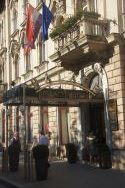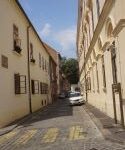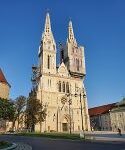July 25, 2013
Zagreb, Croatia
Carolyn and I are in a Palace—the well-named Palace Hotel, that is—in Zagreb, the capital of the newest member of the European Union (as of July), Croatia. Zagreb is a city of almost 1 million people inland from the coast, less congestion than any city I can remember in Europe.
 It’s not actually a “palace”—the last King of Croatia died childless over a thousand years ago, and the King of Hungary was only too happy to join Croatia to the Hungarian Kingdom, beginning a long ménage a trois with Hungary and Austria that lasted until the First World War. The location, however, is palatial, since much of the area beyond the central district has the block housing/high rises that marks Eastern Europe under Communism, when Croatia was one part of Yugoslavia.
It’s not actually a “palace”—the last King of Croatia died childless over a thousand years ago, and the King of Hungary was only too happy to join Croatia to the Hungarian Kingdom, beginning a long ménage a trois with Hungary and Austria that lasted until the First World War. The location, however, is palatial, since much of the area beyond the central district has the block housing/high rises that marks Eastern Europe under Communism, when Croatia was one part of Yugoslavia.
The immediate area of the hotel resembles many of the other former Austrian provincial capitals I’ve visited–such as Lvov. Stately late nineteenth century buildings, large squares with statues of local
heroes (Jelencic here was the governor of Croatia during the 1848 Revolution; he mustered troops to defeat the Hungarian uprising in the vain hope of getting greater autonomy for the Croats; he did get the main square named for him, although I believe the statue was hidden between 1867, when Austria became a “Dual Monarchy” with Hungary and the first world  war), and lots of yellow, solid looking buildings that 18 th century Empress Maria Theresa adored. And because she liked the color, architects liked the color!
war), and lots of yellow, solid looking buildings that 18 th century Empress Maria Theresa adored. And because she liked the color, architects liked the color!
This area is one of three in the central area that distinguish the city. We went through the mostly late 19th century area to get to the two medieval parts that are on the posters. The upper old town had two basic sections—the church and the merchants, occupying two different hills, separated by a now paved-over creek. The church area had the cathedral (the Hungarians established the seat of a bishop, after the Croatians helped the King of Hungary when he fled through the area trying to escape the Mongols, which led to a walled church that is still partly walled). The Church’s original name honored St. Stephen, the Hungarian King who brought Christianity to the Magyars, but today it honors Mary, and was rebuilt in magnificent neo-Gothic after an 1880 earthquake. The German architect who built it, though, had limited funds and built out of sandstone, so the church is currently being rebuilt again, this time with sturdier materials.
church is currently being rebuilt again, this time with sturdier materials.
The merchant side is where the parliament, courts, and president function, and has the old, narrow streets on something of a hill that once provided some protection for the city. Its most prominent feature is the old parish  church of St. Mark, with a roof that our guide said looks like it was “built with Legos”—colorful tile with the shields of Croatia and Zagreb—rather like the church of St. Matthias in Budapest (there’s that Hungarian connection again).
church of St. Mark, with a roof that our guide said looks like it was “built with Legos”—colorful tile with the shields of Croatia and Zagreb—rather like the church of St. Matthias in Budapest (there’s that Hungarian connection again).
We had the tour of the city center this morning, which included the sights above, then had a free afternoon, which I spent conquering as many museums (6) as possible. Many of them were worth visiting for the buildings that housed them. One of the more unusual, included on our tour, was a “Naïve Art” museum, which featured Croatian artists who were part of an early 20th century school that emphasized “primitive” art—colorful pictures, many of peasant life that could easily be mistaken for Brueghel. I had to go to the Mestrovic museum because our guide said Croatia’s most famous sculptor, who studied under Rodin, eventually taught at the University of Chicago, and has a Grant Park statue called the Indians. Now I have to see that one.
The most unusual museum was started by an entrepreneurial type—the Museum of Broken Relationships. If you ever break up with someone, and she/he left something you want to get rid of, and tell the story (“she brought a cat hair roller—it was the only thing she left me”), the museum will be only too happy to get the artefacts from you. As everyone the right age knows, “Breaking up is Hard to do.” But not all of you remember that song.
The Ottomans never got here, partly because of the defense fortress we’re going to see tomorrow.